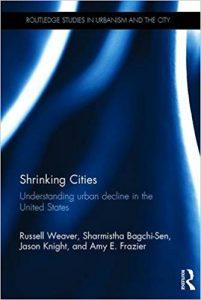
Shrinking Cities: Understanding Urban Decline in the United States
By Russell Weaver, Sharmistha Bagchi-Sen, Jason Knight, and Amy E. Frazier
Routledge (2017)
Cities like Detroit, St. Louis, and Cleveland have lost stunning percentages of their peak population since 1950. Yet these are all in metro areas whose regional populations are much higher than in 1950, even if not at their all time peak high in all of them.
Some cities like Youngstown have gone so far as to try to plan for shrinkage and a permanently reduced population future. Detroit did something similar with its Detroit Future City plan, though that has subsequently been scrapped.
How do we think about shrinkage? How do we define a shrinking city? What should shrinking cities do? These are questions that have been swirling around for the decade I’ve been writing about cities here.
The new academic book Shrinking Cities aims to put some rigor around those questions. The first half of the book is devoted to an examination of shrinkage in the United States. The authors note that any measure designed to identify shrinking cities has a note of the arbitrary about it. The measure they select is population decline of 25% or more over the 40 year period from 1970 to 2010. They look at both census tracts and cities. Surprisingly, they find the shrinking census tracts are very widespread in America, and are on the rise in the Sun Belt. Shrinkage in terms of population loss is not a Rust Belt only phenomenon, though shrinking municipalities as a whole are concentrated in that region.
The authors look at economic decline separately, examining census tracts where there were increasing levels of concentrated disadvantage (which include include such measures as female headed household, unemployment rate, and low educational attainment as disadvantage indicators). Unsurprisingly, economic decline is more common and more severe in shrinking tracts, though there is not complete overlap. They find that social distress is more associated with economic decline whereas physical distress (e.g., vacant housing) is associated more with population decline.
After a presentation of the data, the book reviews various theories of what causes shrinkage and decline such as suburbanization. One that was particularly interesting was the social capital theory. Is low social capital associated with shrinkage and economic decline? It is. One of the indicators of social capital is homeownership. The book observes:
In other words, relative to tracts that shrank and did not decline, tracts that experienced coupled shrinkage and decline witnessed a substantial drop in homeownership rates that cannot be explained by chance alone. If homeownership is a useful indicator of social capital, then his result implies that social capital may have decreased in these shrinking-declining tracts as well. Thus, tracts that are able to keep their homeownership rates steady during population shrinkage may be more resistant to decline via social capital.
The second half of the book looks more at potential strategies for countering or adapting to change. These include various pro-growth policies, “rightsizing”, regional government, community development initiatives, etc. While some of these have had success in isolated cases, none of them have had systemic, replicable success. This makes for a bit of depressing reading. As one person told me about this aspect of the book, “Shrinking cities theory is at a dead end.”
Because of its academic nature, and high price tag, this book is not for everyone. But policy developers in shrinking areas should certainly ground themselves in this summary of shrinking cities research and academic theories found in it.
Aaron M. Renn is a senior fellow at the Manhattan Institute, a contributing editor of City Journal, and an economic development columnist for Governing magazine. He focuses on ways to help America’s cities thrive in an ever more complex, competitive, globalized, and diverse twenty-first century. During Renn’s 15-year career in management and technology consulting, he was a partner at Accenture and held several technology strategy roles and directed multimillion-dollar global technology implementations. He has contributed to The Guardian, Forbes.com, and numerous other publications. Renn holds a B.S. from Indiana University, where he coauthored an early social-networking platform in 1991.
Photo of Brush Park, Detroit by Stephen Harlan, CC BY-SA 2.0












